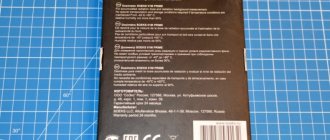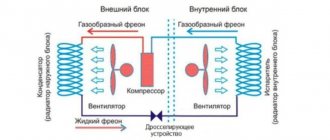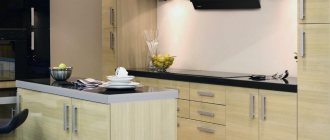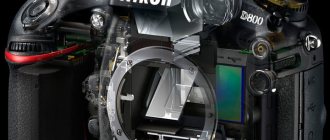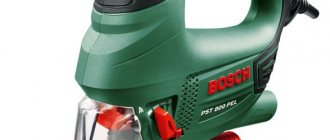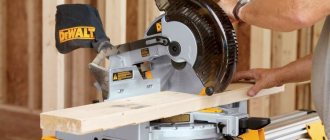Are you planning to build a house or are you renovating? Do you do finishing work professionally? In any of these cases, one of the main conditions for the quality of work (as well as the safety of buildings, if we are talking about their construction) is the accuracy of measurements, strict adherence to horizontal/verticality. This is impossible without a level. The measuring tool is widely used in everyday life and by professional construction teams. In this article we will tell you which laser level to choose for your home, what principle it works on, what it comes in and what to consider when purchasing.
Design and principle of operation
The tool consists of several functional parts:
- high-power LEDs (from which the laser beam is formed);
- prisms and lenses needed for focusing (all together - an optical system);
- stand for installation (tripod, tripod, screws);
- power source (batteries in household models, batteries in professional ones, the latter allow the device to operate for 10 hours without interruption);
- control panel with indicators and buttons;
- durable housing protected from moisture, dust, and foreign objects.
The beam range depends on the model and can reach several tens of meters.
Why do we recommend choosing a laser level rather than a mechanical one? Here are just a few arguments:
- Low error - up to 1 mm per meter. This means that beginners and amateurs can work with the tool.
- No lengthy setup required.
- Ease of use. To take measurements with a laser level, just read the manufacturer's instructions - no special skills are needed.
- You can work without an assistant, which cannot be said about a bubble level or plumb line.
- Less time for the main activity. There is no need to place marks on the surface - the laser point or line is clearly visible on the wall or ceiling, so you can immediately begin repair work, thus saving up to 60% of your time.
Level classes
If you need to choose a device specifically for specialized work, then it is better to be guided by the standards of the State Leveling Network. According to the standards, levels are divided into several classes:
- I – instruments for geodetic and research work. These are high-precision devices, the error of which cannot exceed 0.3 mm.
- II – levels with an error of 2-3 mm.
- III – devices, the error of which can reach up to 5 mm.
Most often, levels are sufficient for construction work, and professional models can correspond in accuracy to class I geodetic levels.
Types of laser levels
Which laser level to choose for the construction of a private house or other building? First of all, you need to understand the types of devices and what each of them is intended for. Depending on the functionality, there are several types of levels.
- Spot. If you have a question about how to choose the right laser level for your own apartment renovation, then buy a point tool. It displays several points in planes, does not form lines, but these points are visible from afar. Dot levels operate almost identically to laser pointers. It is convenient to transfer marks with them, for example, if necessary, hang a shelf or a picture, hang wallpaper, etc. This is a good technique for domestic use, but its capabilities will not be enough for professional builders.
- Linear. Builds lines and forms planes. It is used in construction, finishing, the beam range is up to 20 m, but it is possible to increase it in the presence of an operating mode with a receiver. If you are looking for which laser level to choose for your home, but the simplest (point) level is not suitable, take a closer look at the linear one. Capable of building vertical/horizontal lines and making “crosses.” It is used for finishing work and construction; it is classified as a semi-professional type. The only drawback: the lines are visible only in that part of the room where the level itself is turned. To mark the perimeter, the device will have to be rotated.
- Rotary. Choose a laser level of this type only if you are engaged in construction or finishing professionally; in other cases, it does not justify its price. It is similar in functionality to a linear tool, but it “can” rotate the planes 360 degrees, since it implements a complex mechanism, which is reflected in the cost.
Another classification involves dividing tools into two groups - positional, which includes point and self-leveling linear, and rotary.
Knowing the types of devices and how they differ from each other, you will immediately understand which laser level is best for your tasks.
Types of levels
Let's see what types of laser levels exist.
- Bubble level
The simplest type is the bubble level. It is a wooden or plastic die with built-in capsules containing a colored liquid with an air bubble. The length and width of the device may vary. Transparent capsules are made of durable glass or plastic. Such levels are widely used in household applications. There is a version with a built-in magnet for metal structures. For working with plaster, rules connected to a level are suitable.
- Professional level
The electronic type of instrument can be considered professional level. Its design is almost identical to the bubble level. A distinctive feature is the presence of a display indicating the amount of deviation from the axis and an audible signal that is triggered when 0 or 90 degrees are reached. As a rule, they are equipped with a protractor.
- Pipe level
There is a separate pipe tool for laying different pipes or round profiles. The pipe level is easy to install on a round beam due to its angular shape and the presence of magnets. There are also capsules with air, like the previous types.
- Hydraulic level
When working in one plane and over large distances, for example, laying bricks, installing the foundation of a building, leveling a floor, a hydraulic level would be a good choice. It is a transparent cabin from 5 to 25 m long. At its ends there are special containers with a scale. After filling the level with water, you should get rid of air bubbles and level the water level in the containers to the same level.
Among the professional models there are levels - laser levels. This is a more expensive, but also more accurate instrument with the lowest possible error value. Allows you to construct different planes over large distances.
Measuring range
If you are faced with the question of which laser level to choose for your home, and you are not going to perform complex actions, then take a simple tool with a range of 2-20 meters, this is quite enough for repairs and simple finishing. They are relatively inexpensive and require less energy. If construction and repair are your professional field of activity, you often work in open areas, you need models with a range of 50 m or more.
Some levels are connected to a receiver, which increases the beam range by 2-3 times. In this case, the technical data sheet indicates two numbers, for example, 50/100. The first means standard range, the second means with a receiver. If there is no second number, then the level is not connected to the receiver, and it is impossible to increase the range.
Conclusion
Laser levels are high-precision measuring equipment that simplifies and speeds up marking and finishing work, as well as improving their quality. And laser levels with a green beam also provide the ability to work in bright daylight without overvoltage.
The forum has a whole section dedicated to measuring equipment, where you can find useful information, ask questions and discuss different types of instruments. One of the most popular types of flooring is porcelain stoneware, the installation of which will be made much easier with a laser level. The video shows interior solutions for a cube house.
Subscribe to our Telegram channel Exclusive posts every week
Tips for choosing
When choosing a device, you need to clearly think through the work plan, and in accordance with this, choose the model of the level and the equipment of the level.
In addition, you need to make sure that the case is sufficiently strong and protected from moisture. Work with this device usually takes place in an environment that is unsafe for a precision instrument; for this reason, a fall or a strong impact can disrupt the settings. Greater strength of the case will help avoid accidental inaccuracies.
Everyone chooses the manufacturer themselves. However, a more well-known brand will help avoid problems with warranty, service or counterfeiting.
A household bubble level is sufficient for most types of home renovations. The purchase of a more expensive device should be motivated by the corresponding type of work performed.
Before purchasing, you need to check the readings of the device by turning it on and setting the horizon. If the readings are correct and clear, you can make a purchase.
A simpler level is much easier to repair. For this reason, repairing such a device will be cheaper.
During construction (installation of foundations, erection of walls and other types of work), a large error can cause an accident, leading to catastrophic consequences, including death. This can occur both during construction and during operation. In order to avoid this, you should choose a level with the smallest possible error. In this case, high-precision professional models are suitable.
Device structure
The variety of models is huge, but the principle of laser levels is the same for all models.
A high power LED serves as an emitting source. As a rule, two colors are used - green or red. Such rays are brighter and more visible. The rays of such an emitter have a certain wavelength and low heat transfer. They are not afraid of mechanical damage and are economical in energy consumption. The green beam design is an innovation, it is slightly more expensive and absorbs more energy.
Various lenses and prisms provide the optical system needed to direct and shape the beam. The lens system can be either movable or fixed.
There is also a control system, which is a push-button control panel. Some models have a control panel.
Power comes from batteries or accumulator. In the latter case, the kit includes a power supply for charging.
Types of levels
Laser types of levels are also divided into different types. Their price depends on the complexity and functionality of the device.
The most inexpensive levels are discrete . They place at least two points on the plane. This tool can be called a type of laser pointer. The advantage is the long beam range - up to 400 m. However, this is not the most accurate version of the level. Also, it cannot be moved - inaccuracies immediately appear. The error compared to other levels is large.
Linear (dramatic) show entire lines, forming planes. This happens thanks to an additional lens. The markings run throughout the entire room. There is an auto-leveling system. However, the beam length is no more than 60m, and at long distances specialized glasses are required.
A rotating level is called a rotary level. He builds planes not only in straight lines, but also in inclined directions. There is a leveling system. The beam length is up to 300 m, and it is clearly visible at a maximum distance. The most expensive level option.
Operating rules
Like any other tool, a level requires following basic rules when performing work.
- You must read the instructions carefully. Different models may require different ways to adjust the level, which largely determines the quality of work.
- Initially, you need to make sure that the batteries are new (the battery is charged) and the device is ready to turn on.
- Having turned on the device, we make sure that it is in working condition by the presence of a beam or dot.
- The laser easily injures the retina of the eyes, for this reason you need to loudly notify everyone present about the start of the work.
- Obstacles in the path of the beam distort the final result. It is necessary to clear the room of such things.
- The shorter the distance to the wall, the more accurate the level readings.
- An even, firm level setting will help avoid deviations.
- After this, we level it horizontally, enter the required values according to the instructions and begin work.
If these steps are followed, the operation of the device will be as accurate and reliable as possible.
Parameters for choosing a level for construction/repair
If you are planning a full-scale renovation or starting construction, the following set of characteristics will be optimal for choosing a laser level:
- Two planes - vertical and horizontal with the possibility of their separate inclusion.
- Zenith, nadir and plumb.
- The scanning angle of the planes is about 120-140°; you can get a full 360° by rotating it several times.
- Self-leveling with position change alarm.
- Possibility of locking self-leveling.
- A bright beam with a range of at least 10-15 m.
You may also need a receiver, so the level must work with it.
You also need to choose a laser level by manufacturer
The following devices satisfy these conditions:
- Bosch GLL 2-40 — $170GLL
- Infiniter CL2 – $200
- 2 Professional – $200
- Geo-Fennel 40 pocket 2 — $220
- GTL 3 Professional - $220
- RED 2D Condtrol - $250
- Condtrol Laser 3D - $250
- Condtrol XLiner Combo - $280
- Bosch GLL 2-50 — $270
- X-Line Master 4D – $285
These are just a few of the suitable laser levels. As additional selection markers, you can add a fixation method (magnets, for example), the presence of a case or tripod in the basic configuration. Or those additional features that seemed convenient to you.
Additional options and features
In addition to the main parameters, there are also some additional ones. They make things easier, so it's more about usability. After all, additional functions affect the final result only indirectly or partially.
Self-leveling
In order for the measurements to be correct, the level must be installed vertically upward. In simple models, their position is checked with simpler devices, usually a bubble level. In some models it is built into the body, in others it is not. Then you have to resort to ordinary construction, which is not entirely convenient. In addition, incorrect readings are possible - if during operation it changes position and you do not see it, the work will be performed incorrectly. To avoid such a situation, you have to double-check the position of the device several times.
Self-leveling (self-compensation of a small angle of inclination)
Some laser levels have a self-leveling or self-leveling feature. When deviating from the vertical by a small angle (usually up to 4°), they adjust the position of the mirrors and prisms so that all readings are correct. If the tilt exceeds the maximum permissible, they either make a sound/give a light signal, or turn off the beams. Operation is restored when returning to normal.
Having a laser level with this function makes it easy to set up the device at the very beginning of work. Also, during its use, you don’t have to worry that it has changed position - it will give a signal.
However, sometimes the level needs to be set at a certain angle. The presence of a self-leveling function will not allow this to be done. Therefore, it is advisable to purchase a model in which this function can be blocked.
Self-shutdown
This function allows you to save battery power. If the device does not move for 10-15 minutes, it turns off. On the one hand, this is useful, on the other hand, some jobs require more than 15 minutes and shutting down can be annoying. Whether you need this feature or not is up to you.
Automatic shutdown is not always good
Operating temperature
If you plan to work in the warm season or only indoors, the temperature does not matter. Basically, a laser level can be operated at temperatures from +5°C to +40°C, that is, they are only suitable for heated rooms or work in the warm season.
Most laser levels are designed to work in a heated room
If you need to choose a laser level for working outdoors with the possibility of operation in the cold season, there are “frost-resistant” models that can withstand temperatures down to -10°C. Even more frost-resistant ones must be looked for specifically; there are very few of them.
Mounting type
In addition to the standard installation of the laser level on a horizontal plane, there may be several additional options for mounting it:
We advise you to study - Question: what wallpaper to choose for the hallway and corridor
On a special tripod. Most often needed for outdoor work, but some work (drawing horizontal lines on walls when hanging furniture, for example) is also easier to do with a tripod. A tripod is sometimes included, sometimes purchased separately
When purchasing, pay attention to the diameter of the thread on the body of the level - the tripod must have the same one. On magnets. Magnets are soldered into the body of some models
This makes it possible to attach it to any metal surface/part. The type of fastening affects the ease of use. On a special magnetic stand. Some models of laser levels come with a small plastic pad into which magnets are soldered. A platform is installed on a metal surface, and a level is placed on it. Self-tapping screw/nail. A special hole is made in the body of the level into which the head of a nail or self-tapping screw is threaded. Not the most convenient way of fastening, but still.
Everything is clear with these options. You can, of course, do without them, come up with your own way. These are simply opportunities for more comfortable operation.
Shockproof housing and the possibility of self-adjustment (adjustment)
It is very useful if the laser level has a shockproof housing. Construction or repair is a high-risk area for any tool, so it often falls. If the case is shockproof, there is a high probability that even after a fall it will survive.
A shockproof case wouldn't hurt
If dropped or carelessly transported, the level's settings may be lost and it may begin to lie. To eliminate this “phenomenon”, some devices provide the ability to independently configure
For this you will need to carry out certain manipulations described in the instructions.


